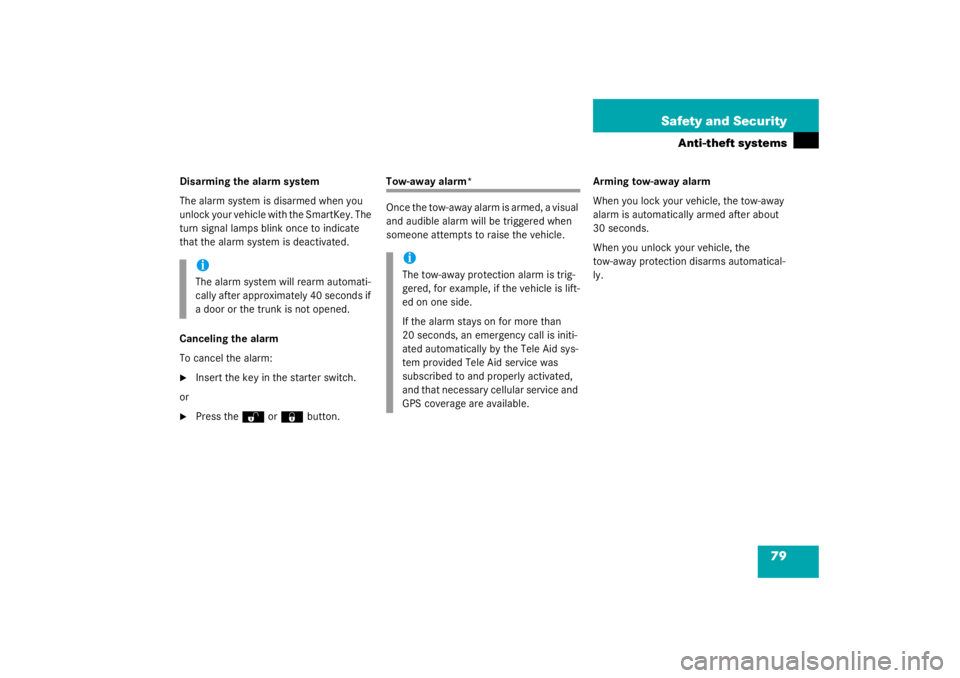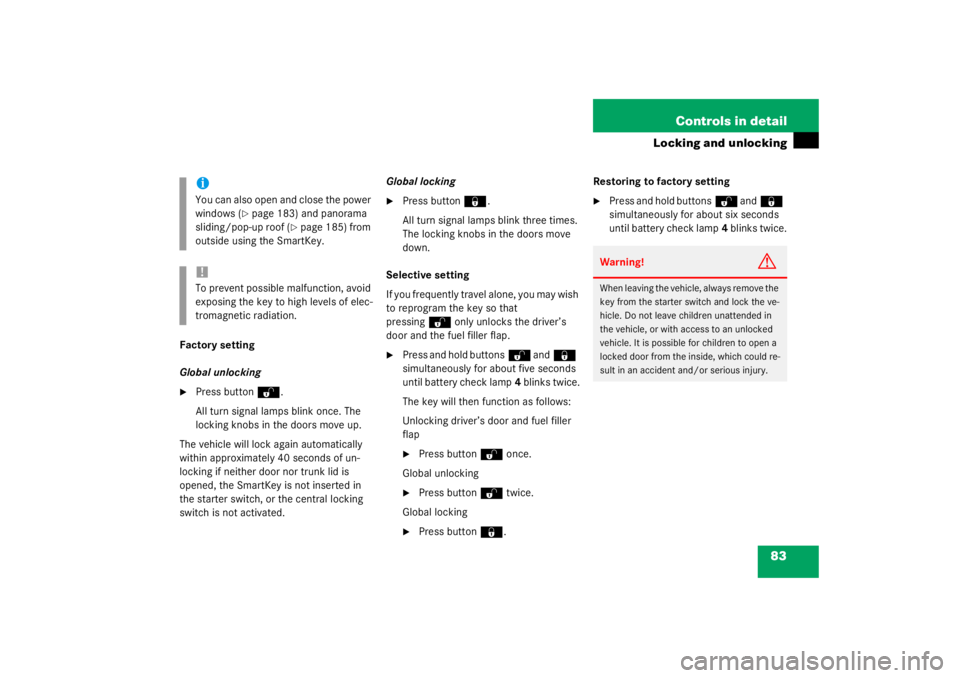Page 73 of 356

73
Safety and Security
Driving safety systems
Driving safety systems
In this section you will find informations on
the following driving safety systems:�
ABS (A
ntilock B
rake S
ystem)
�
BAS (B
rake A
ssist S
ystem)
�
ESP (E
lectronic S
tability P
rogram)
ABS
The ABS regulates the brake pressure so
that the wheels do not lock during braking.
This allows you to maintain the ability to
steer your vehicle.
The ABS is functional above a speed of ap-
proximately 5 mph (8 km/h) independent
of road surface conditions.
At the instant one of th e wheels is about to
lock up, a slight pulsation can be felt in the
brake pedal, indicating that the ABS is in
the regulating mode. Keep firm and steady
pressure on the brake pedal while experi-
encing the pulsation. Continuous steady brake pedal pressure
yields the advantages provided by the ABS,
namely braking power and ability to steer
the vehicle.
On slippery road surfaces, the ABS will re-
spond even with light brake pressure. The
pulsating brake pedal can be an indication
of hazardous road conditions and func-
tions as a reminder to take extra care while
driving.
iIn winter operation, the maximum ef-
fectiveness of the ABS, ESP is only
achieved with winter tires (M + S tires),
or snow chains as required.Warning!
G
The following factors increase the risk of ac-
cidents:�
Excessive speed, especially in turns
�
Wet and slippery road surfaces
�
Following another vehicle too closely
The ABS, BAS, ESP cannot reduce this risk.
Always adjust your driving style to the pre-
vailing road and weather conditions.
Warning!
G
Do not pump the brake pedal. Use firm,
steady brake pedal pressure instead. Pump-
ing the brake pedal defeats the purpose of
ABS and significantly reduces braking effec-
tiveness.
iTo alert following vehicles to slippery
road conditions you discover, operate
your hazard warning flashers as appro-
priate.
Page 74 of 356

74 Safety and SecurityDriving safety systems
ABS control
The
-
malfunction indicator lamp in the
speedometer lights up when you turn the
key in the starter switch to position 2. It
goes out when the engine is running.
More information can be found in the
“Practical hints” section (
�page 247).
BAS
The Brake Assist System (BAS) operates in
emergency situations. If you apply the
brakes very quickly, the BAS automatically
provides full brake boost, thereby poten-
tially reducing the braking distance. Apply
continuous full braking pressure until the
emergency braking situation is over. The
ABS will prevent the wheels from locking.
When you release the brake pedal, the
brakes function again as normal. The BAS
is then deactivated.
More information can be found in the
“Practical hints” section (
�page 254).
Warning!
G
The ABS cannot prevent the natural laws of
physics from acting on the vehicle, nor can
it increase braking or steering efficiency be-
yond that afforded by the condition of the
vehicle brakes and tires or the traction. The
ABS cannot prevent accidents, including
those resulting from excessive speed in
turns, following another vehicle too closely,
or aquaplaning. Only a safe, attentive, and
skillful driver can prevent accidents. The ca-
pabilities of an ABS equipped vehicle must
never be exploited in a reckless or danger-
ous manner which could jeopardize the us-
er’s safety or the safety of others.
Page 78 of 356

78 Safety and SecurityAnti-theft systems
Anti-theft systemsImmobilizer
The immobilizer prevents unauthorized
persons from starting your vehicle.
Activating�
Removing the key from the starter
switch activates the immobilizer.
Deactivating
�
Inserting the key in the starter switch
deactivates the immobilizer.
Anti-theft alarm system*
Once the alarm system has been armed, a
visual and audible alarm is triggered when
someone opens�
a door
�
the trunk lid
�
the hood.
The alarm will stay on even if the activating
element (a door, for example) is immedi-
ately closed.
The alarm system will also be triggered
when
�
someone attempts to raise the vehicle
�
the vehicle is opened with the mechan-
ical key. Arming the alarm system
The alarm system is armed after locking
the vehicle with the SmartKey. The turn
signal lamps blink three times to indicate
that the alarm system is activated. The in-
dicator lamp
in the switch for the tow-away
alarm will blink after approximately 10 sec-
onds when the alarm system is completely
armed (
�page 80).
iIn case the engine cannot be started
(yet the vehicle’s battery is charged),
the system is not operational. Contact
an authorized Mercedes-Benz Center
or call 1-800-FOR-MER-Cedes (in the
USA), or 1-800-387-0100 (in Canada).
iIf the alarm stays on for more than
20 seconds, an emergency call is initi-
ated automatically by the Tele Aid sys-
tem* provided Tele Aid service was
subscribed to and properly activated,
and that necessary cellular service and
GPS coverage are available.iIf the turn signal lamps do not blink
three times one of the following ele-
ments may not be properly closed:�
a door
�
the trunk lid
�
the hood
Close the respective element and lock
the vehicle again.
Page 79 of 356

79
Safety and Security
Anti-theft systems
Disarming the alarm system
The alarm system is disarmed when you
unlock your vehicle with the SmartKey. The
turn signal lamps blink once to indicate
that the alarm system is deactivated.
Canceling the alarm
To cancel the alarm:�
Insert the key in the starter switch.
or
�
Press the
Œ
or
‹
button.
Tow-away alarm*
Once the tow-away alarm is armed, a visual
and audible alarm will be triggered when
someone attempts to raise the vehicle. Arming tow-away alarm
When you lock your vehicle, the tow-away
alarm is automatically armed after about
30 seconds.
When you unlock your vehicle, the
tow-away protection disarms automatical-
ly.
iThe alarm system will rearm automati-
cally after approximately 40 seconds if
a door or the trunk is not opened.
iThe tow-away protection alarm is trig-
gered, for example, if the vehicle is lift-
ed on one side.
If the alarm stays on for more than
20 seconds, an emergency call is initi-
ated automatically by the Tele Aid sys-
tem provided Tele Aid service was
subscribed to and properly activated,
and that necessary cellular service and
GPS coverage are available.
Page 80 of 356
80 Safety and SecurityAnti-theft systemsDisarming tow-away alarm
To prevent triggering the tow-away alarm
feature, switch off the tow-away alarm be-
fore towing the vehicle, or when parking on
a surface subject to movement, such as a
ferry or auto train.1 Tow-away alarm off switch
2 Indicator lamp
The switch is located on the center con-
sole.�
Turn off the ignition and remove the
key.
�
Press upper half 1 of the switch.
Indicator lamp 2 in the switch lights up
briefly.
�
Lock your vehicle with the key.
The tow-away alarm remains disarmed un-
til you lock your vehicle again.iYou cannot disarm the tow-away alarm
if the ignition is turned on.
Page 81 of 356
81
Controls in detail
Locking and unlocking
Seats
Memory function*
Lighting
Instrument cluster Control system
Manual transmission
Automatic transmission*
Good visibility
Climate control
Automatic climate control* (Canada only) Audio system
Power windows
Panorama sliding/pop-up roof*
Driving systemsLoading
Useful features
Page 82 of 356

82 Controls in detailLocking and unlockingIn the “Controls in detail” section you will
find detailed information on how to oper-
ate the equipment installed on your vehi-
cle. If you are already familiar with the
basic functions of your vehicle, this section
will be of particular interest to you.
To quickly familiarize yourself with the ba-
sic functions of the vehicle, refer to the
“Getting started” section of this manual.
The corresponding page numbers are giv-
en at the beginning of each segment.
Locking and unlockingInformation on locking and unlocking can
be found in the “Getting started” section
on (
�page 30) and (
�page 51).
SmartKey
Your vehicle comes supplied with two
SmartKeys with remote controls and a re-
movable mechanical key. The locking tabs
for the mechanical key portion of the two
keys are a different color to help distin-
guish each key unit.
The remote control key provides an ex-
tended operating range. To prevent theft,
however, it is advisable to only unlock the
vehicle when you are in close proximity to
it.
The key centrally locks and unlocks:�
the doors
�
the trunk lid
�
the fuel filler flap
SmartKey with remote controls1‹
Lock button
2 Mechanical key locking tab
3
Œ
Unlock button
4 Battery check lamp
5
Â
Panic button* (
�page 72)
iCanada only:
Only vehicles equipped with an
anti-theft alarm system* have
SmartKeys with integrated panic
button* 5.
Page 83 of 356

83
Controls in detail
Locking and unlocking
Factory setting
Global unlocking�
Press button
Œ
.
All turn signal lamps blink once. The
locking knobs in the doors move up.
The vehicle will lock again automatically
within approximately 40 seconds of un-
locking if neither door nor trunk lid is
opened, the SmartKey is not inserted in
the starter switch, or the central locking
switch is not activated. Global locking
�
Press button
‹
.
All turn signal lamps blink three times.
The locking knobs in the doors move
down.
Selective setting
If you frequently travel alone, you may wish
to reprogram the key so that
pressing
Œ
only unlocks the driver’s
door and the fuel filler flap.
�
Press and hold buttons
Œ
and
‹
simultaneously for about five seconds
until battery check lamp 4 blinks twice.
The key will then function as follows:
Unlocking driver’s door and fuel filler
flap
�
Press button
Œ
once.
Global unlocking
�
Press button
Œ
twice.
Global locking
�
Press button
‹
. Restoring to factory setting
�
Press and hold buttons
Œ
and
‹
simultaneously for about six seconds
until battery check lamp 4 blinks twice.
iYou can also open and close the power
windows (
�page 183) and panorama
sliding/pop-up roof (
�page 185) from
outside using the SmartKey.
!To prevent possible malfunction, avoid
exposing the key to high levels of elec-
tromagnetic radiation.
Warning!
G
When leaving the vehicle, always remove the
key from the starter switch and lock the ve-
hicle. Do not leave children unattended in
the vehicle, or with access to an unlocked
vehicle. It is possible for children to open a
locked door from the inside, which could re-
sult in an accident and/or serious injury.